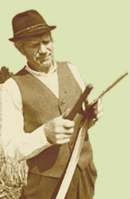Browsing the first pages of the lake mud book of Rõuge
Siim Veski, Atko Heinsalu and Kalev Koppel have gained quite some information about the development of the surroundings of Lake Tõugjärv, in South Estonia, with the help of annually laminated lake sediments. The organic sediments can say a lot about past climate, development of agriculture and increase of pollution. However, there are very few lakes in Estonia that have suitable annually laminated sediments, and Lake Tõugjärv at Rõuge is one of them. The pollen data reveal the extensive cultivation of cannabis in Rõuge area and correlates well with the data from historical sources, showing the increases and decreases in past population and the number of domestic animals.
The non-existent ecological catastrophe at Saaremaa 800400 years B.C.
Anto Raukas, Kustav Laigna and Tanel Moora do not believe that the Kaali meteorite fell only a couple of thousand years ago, thus opposing some scientists views. They indicate that there are many proofs that rule out the possibility of the meteorite falling just 2000 years ago. They also question the status of Kaali Lake as a holy one.
Magpie the bird of the year.
Jaanus Aua describes the bird of the year 2003 the magpie, its habits, wisdom and prudence. The magpie is known as the most intelligent warbler and the bird of white and black feathers. Interestingly enough, none of the magpies dark feathers are really black, but green, purple, blue or brown.
Maple is honeyed in spring and golden in autumn
Ivar Sibul gives an overview of the tree of the year 2003 maple, the tree that is common near the settlements, but rare in nature. He describes the habitat conditions and timber of the tree and explains the reasons for spring bleeding and autumn colours. Some interesting varieties are pointed out as well.
Essay
Raivo Mänds essay about ecosystem engineers.
The impressive berrycones of juniper
Urmas Kokassaar knows the good aspects of juniper: since ancient times its special taste and curative qualities have been highly appreciated in kitchen and sickbeds. He lists the numerous valuable bioagents of dried berries. There are also many alcoholic drinks that use juniper berries as basic taste agents. The berries are used in cooking as well as in biological medicine.
Leidissoo Nature Protection Area
Tiit Randla introduces very diverse mire in North-West Estonia the Leidissoo mire, and its species rich bird life. The mire has not been studied much; most research has been focused on avifauna. The reason for the very rich bird fauna is the abundance of different habitats suitable for many rare birds, especially harriers and owls. The aim of the nature protection area is preserve the landscapes habitats in their almost pure natural state.
European rarities in Estonia
Henn Timm depicts a rare diving beetle, Dytiscus latissimus. The rather large diving beetle is most threatened by eutrophication of water bodies. However, our knowledge about the species is too sparse to make any further generalizations about its status in Estonia.
The intergration of our wildlife into European Union
The discussion panel between nature conservationists, zoologists and hunters about the future of wolf, lynx, bear and beaver in Estonia, after joining the European Union. The panel is mediated by Ann Marvet.
Practical tips: how to recognize plants in winter
Ülle Reier helps to identify dry plants that are bristling up from the snow. She advises to pay attention to certain parts of the plant. The numerous winter photos of our common plants make the identification even easier.
Bridge to Finland: a travelogue of Finnish nature and man, who bustles in the nature.
Teet Koitjärv recommends Finland as a travel destination. How much do we really know about our neighbor? In this story we learn about Finnish nature and about the places where to learn: the nature centers of Finland. Some protected areas are visited as well.
The big surprises of the poor mushroom season
Erast Parmasto shares the mycologists joy over finding some especially rare mushroom species that, being species of southern dispersal, took advantage of the exceptionally dry and hot summer and created particularly big sporocarps. He also gives advice about how to act if one should come across a rare mushroom.
Eesti Loodus enquires
Urmas Tartes explains the essence of everyones right in Estonia.
Kaja Lotman describes the diploma of European Protected Areas and its meaning to Matsalu Nature Conservation Area.
| 

![[IN ENGLISH]](images/gb.gif)






